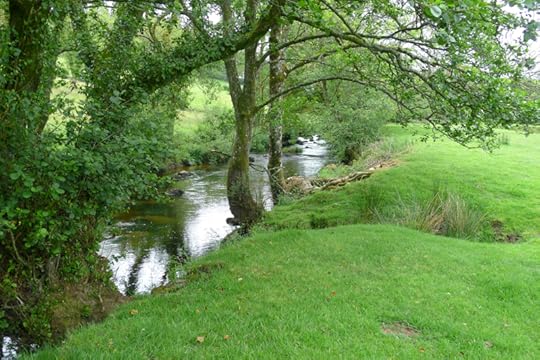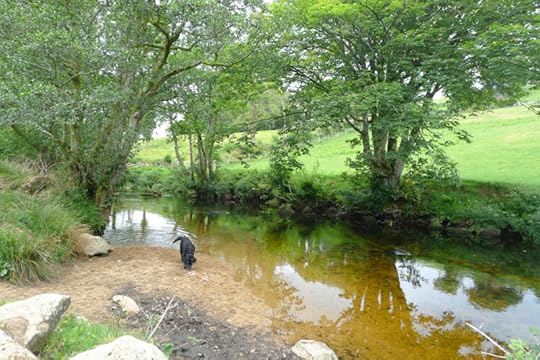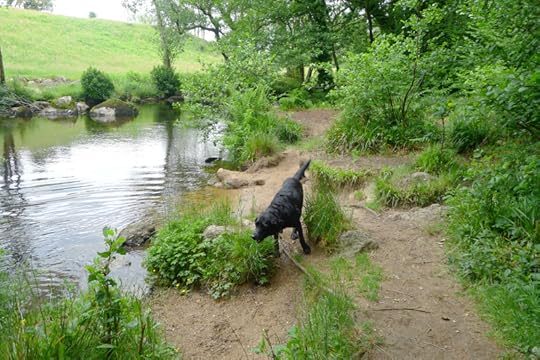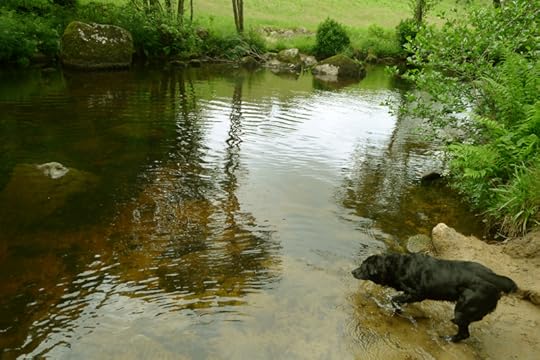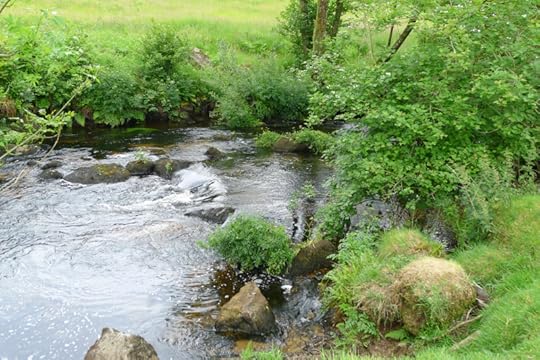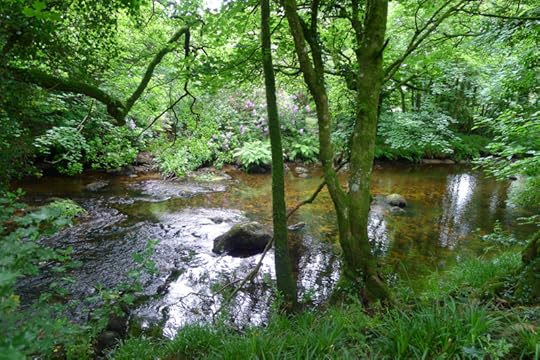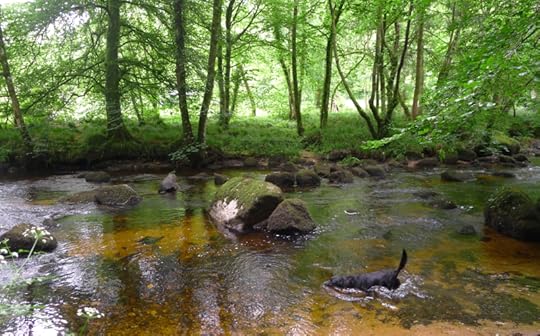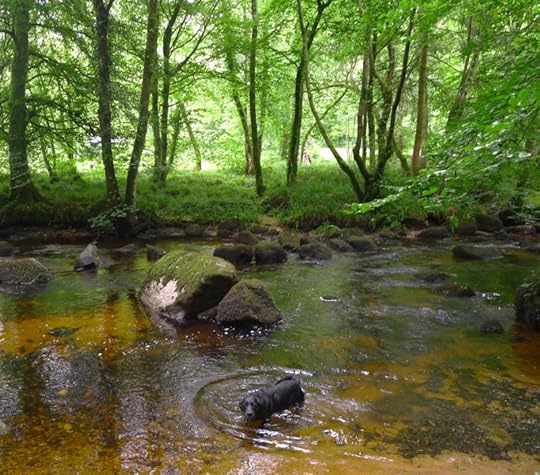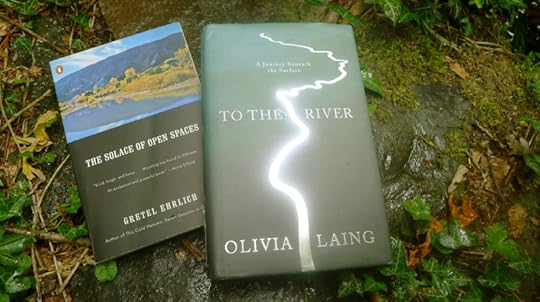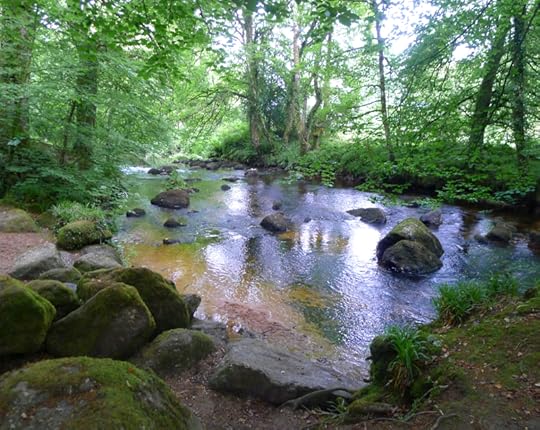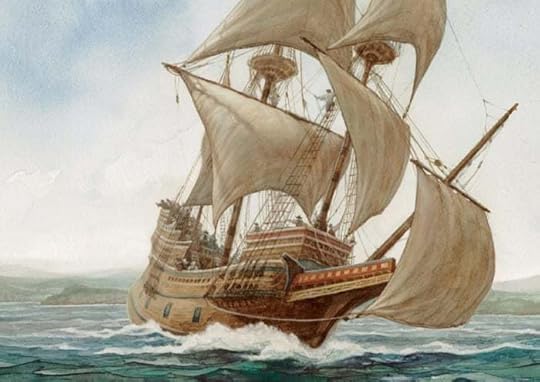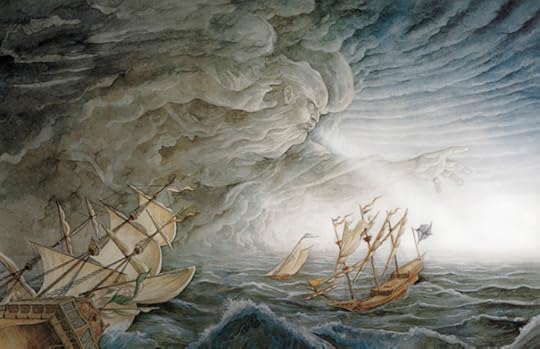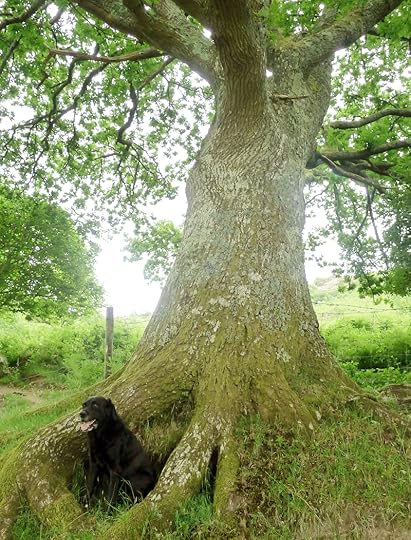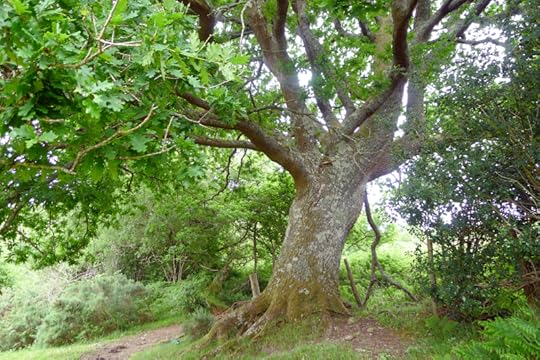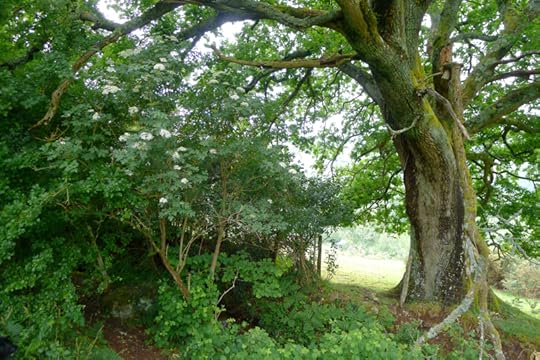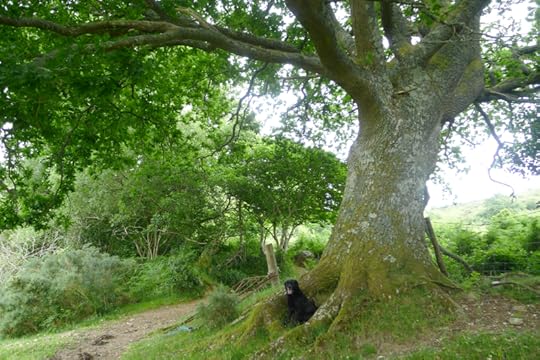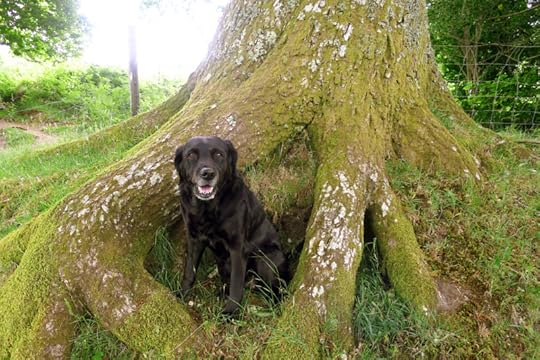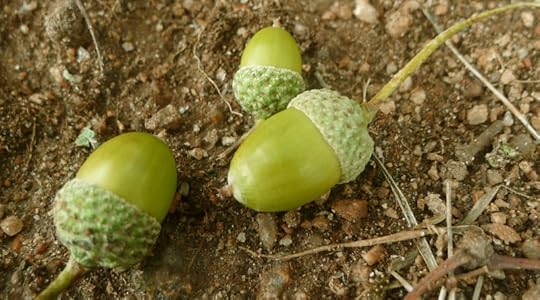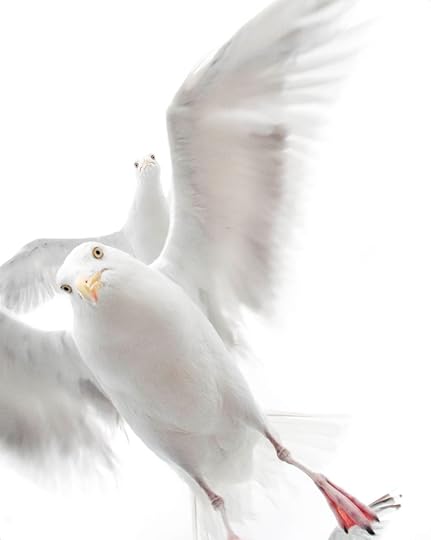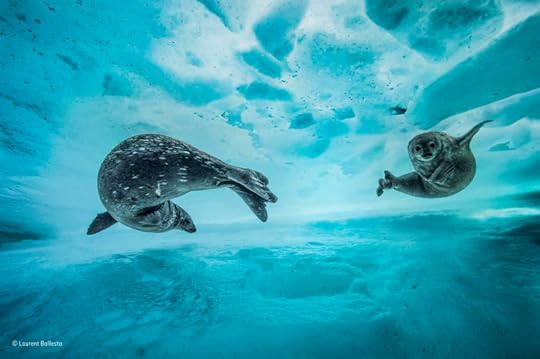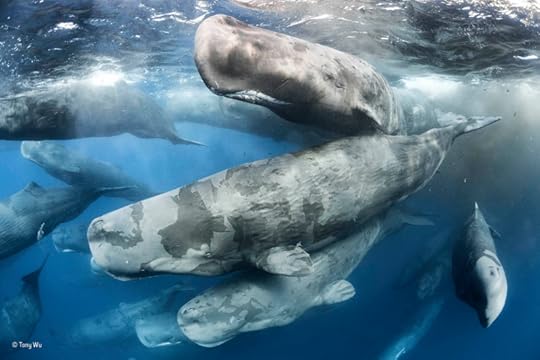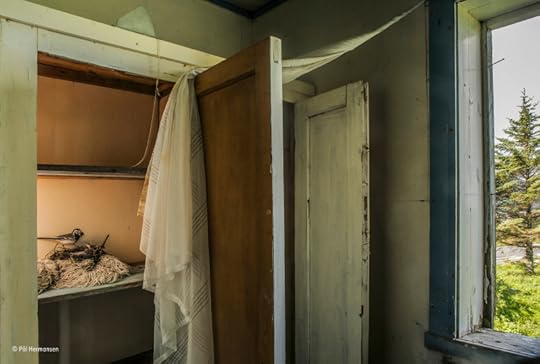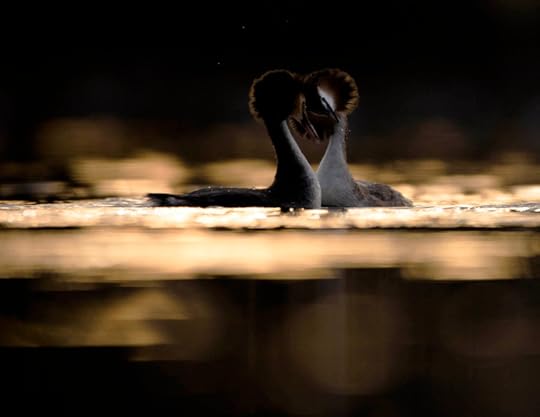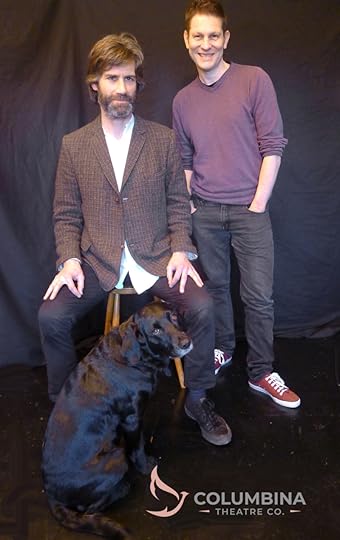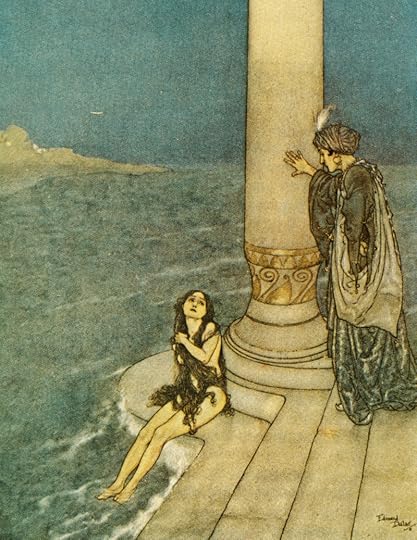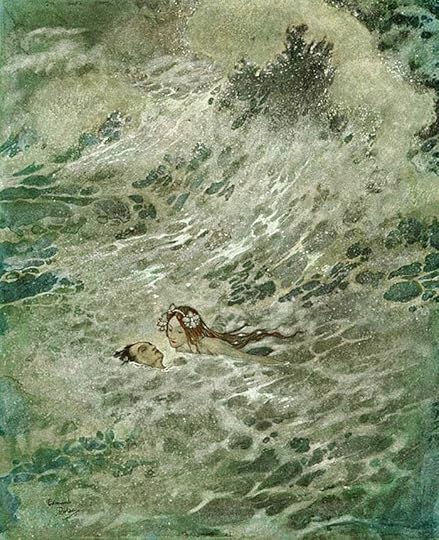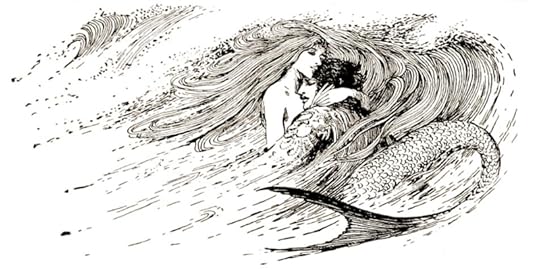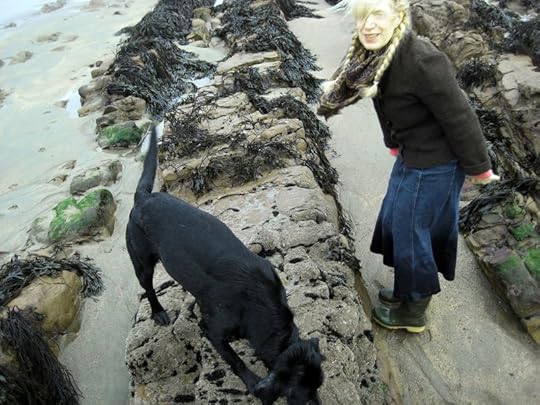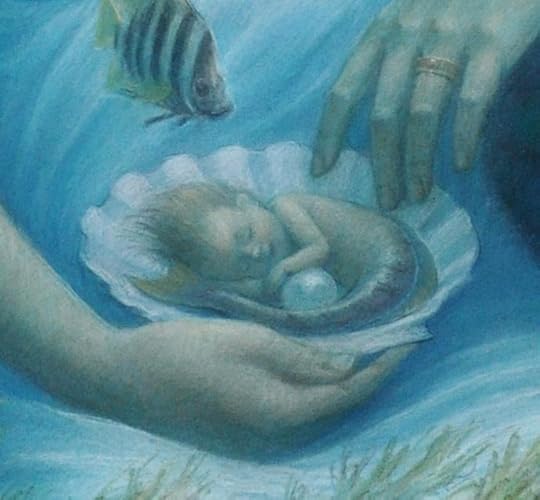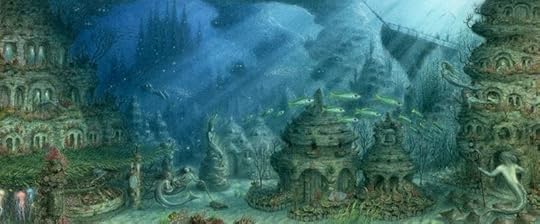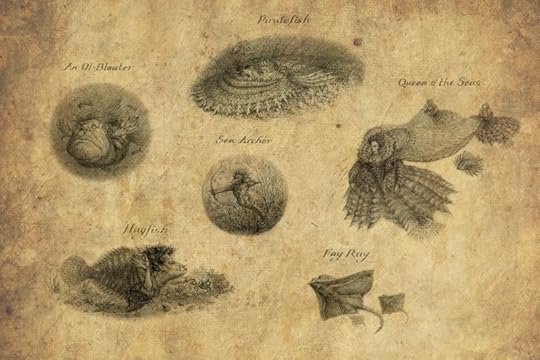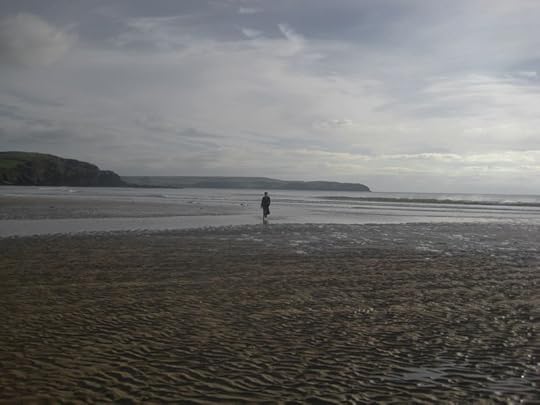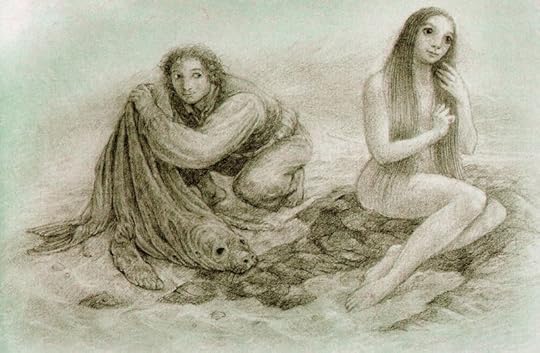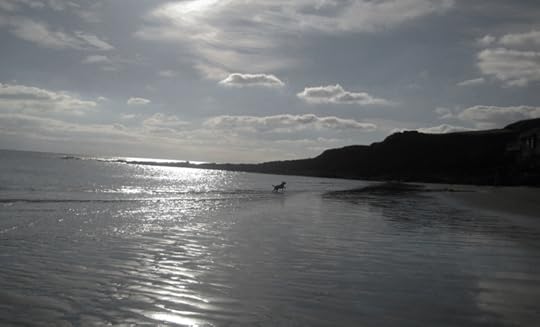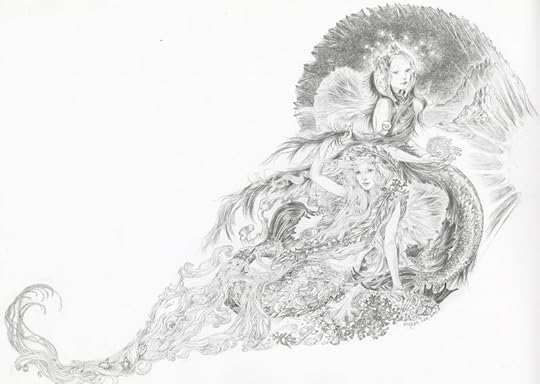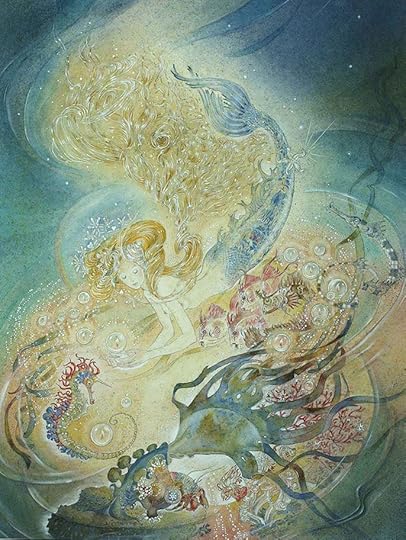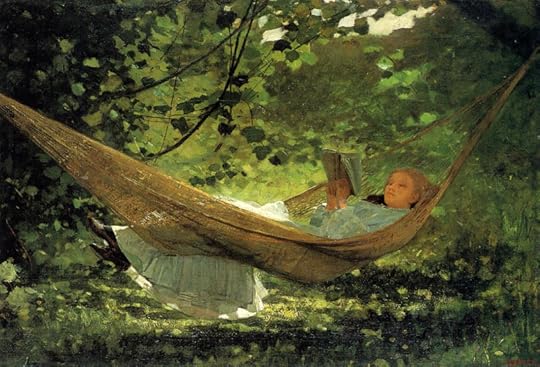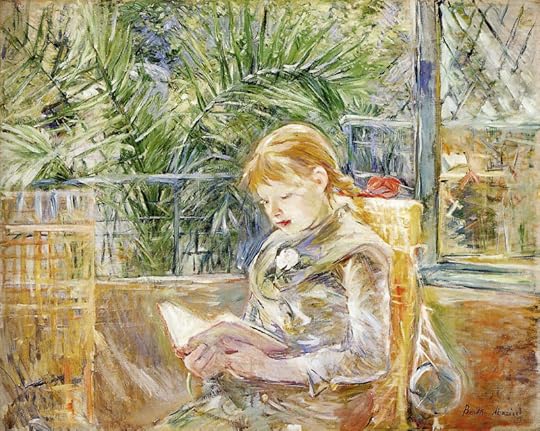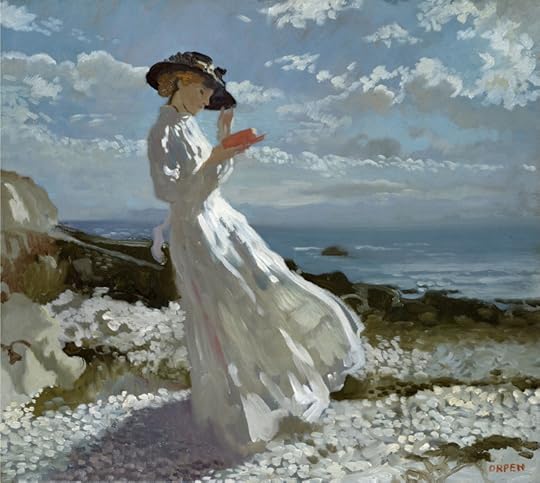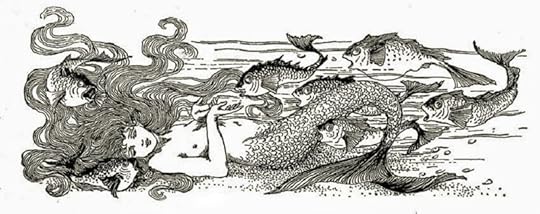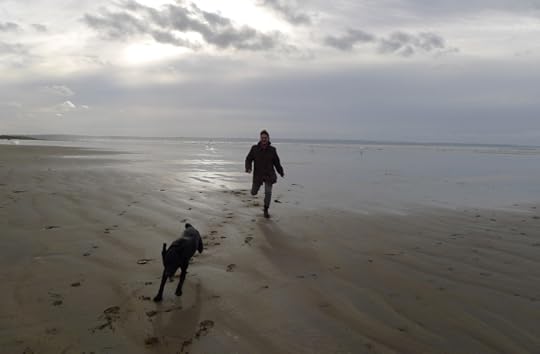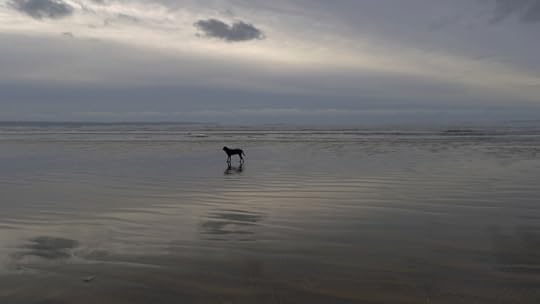Terri Windling's Blog, page 33
June 16, 2020
Down by the river
I've been out of the studio today for health reasons again -- not my own health this time, but Tilly's. She has an immune system condition that requires monthly injections, which is usually a simple affair -- but with our local vet centre closed during the Covid-19 lockdown, it requires a trip to another town and elaborate procedures to do it all safely. Our poor girl hates every minute of it, so her reward for being a Very Good Dog is a walk and swim in the River Teign.
Tilly loves water in all of its forms: rivers, ponds, lakes, oceans, she plunges fearlessly into them all. And had the morning been just a little bit warmer, I would have been right behind her....
"I am haunted by waters," writes Olivia Laing in her book To the River. "It may be that I���m too dry in myself, too English, or it may be simply that I���m susceptible to beauty, but I do not feel truly at ease on this earth unless there���s a river nearby. 'When it hurts,' wrote the Polish poet Czes��aw Mi��osz, 'we return to the banks of certain rivers,' and I take comfort in his words, for there's a river I've returned to over and over again, in sickness and in health, in grief, in desolation and in joy."
For me, that river is the Teign, running from Dartmoor to the south Devon coast.
"Everything in nature invites us to be constantly what we are," says American naturalist Gretel Ehrlich. "We are often like rivers: careless and forceful, timid and dangerous, lucid and muddied, eddying, gleaming, still. Lovers, farmers, and artists have one thing in common, at least -- a fear of 'dry spells,' dormant periods in which we do no blooming, internal droughts that only the waters of the imagination and psychic release can civilize. All such matters are delicate, of course. But a good irrigator knows this: too little water brings on the weeds while too much degrades the soil....In his journal Thoreau wrote, 'A man's life should be as fresh as a river. It should be the same channel but a new water every instant.' "
I'll be back in the studio tomorrow. Today, I am following the river...and a wet, happy hound.
The passages quoted above are from To the River: A Journey Beneath the Surface by Olivia Laing (Canongate Books, 2011) and The Solace of Open Spaces by Gretel Ehrlich (Penguin Books, 1985). The poem in the picture captions is from The Caged Owl: New & Selected Poems by Gregory Orr (Copper Canyon Press, 2002). All rights reserved by the authors.
June 14, 2020
Tunes for a Monday Morning
After songs of the sea last week, here are songs of sailors and sailing ships from the British Isles and North America....
Above: "The Bonny Ship the Diamond" performed by Beoga (Sean Og Graham, Damian McKee, Niamh Dunne, Eamon Murray, Liam Bradley) from Co. Kerry, Ireland. The song appeared on their seventh album Before We Change Our Mind (2016).
Below: "Banks of the Newfoundland" peformed by Teyr (James Patrick Gavin, Dominic Henderson, Tommie Black-Roff), based in London. The song appeared on their debut album, Far From the Tree (2016).
Above: "William Taylor" performed by multi-instrumentalist Sam Sweeny and singer and accordionist Hannah James. The song appeared on their second collaborative album, State and Ancientry (2012).
Below: "Cruel" performed by singer/songwriter Kate Rubsy, from Yorkshire. The song appeared on her sixth album, Underneath the Stars (2003).
Above: Cyril Tawney's "The Grey Funnel Line," performed by the great English folk singer June Tabor. She first recorded the song with Maddy Prior for their collaborative album Silly Sisters (1976). This haunting solo version appeared on Tabor's Ashore (2011).
Below: "Maid on the Shore" performed by folk singer and fiddle player Eliza Carthy, from Yorkshire. The song appeared on her seventh solo album Rough Music (2004).
Above: "Demon Lover" (also known as The House Carpenter, Child Ballad #243), performed by American roots musician Tim O'Brien, with backing vocals by Irish singer Karen Casey. The song appeared on O'Brien's album Two Journeys (2001).
Below: "The Golden Vanity" performed by the American folk & bluegrass band Crooked Still, sung by Aoife O'Donovan. The song was filmed last year for Chris Thile's television program Live from Here.
One more to end with: "Lord Franklin," a 19th century broadside ballad about Franklin's ill-fated expedition to the Artic in 1845. This simple, lovely version is from John Smith's album Hummingbird, recorded in Somerset last year.
The art today is by the extraordinary Irish book artist P.J. Lynch. To see more of his beautiful work, go here.
June 13, 2020
Ask, what are my gifts?
From "The Shining, Reflective Sheild: An Interview with Kathleen Dean Moore" by Miranda Perrone:
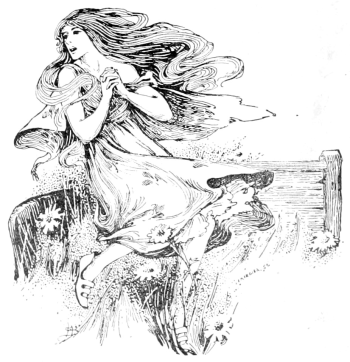 Kathleen Dean Moore: The morning after Donald Trump pulled the U.S. out of the Paris Climate Accords, this old climate warrior climbed out of bed feeling better about the chances of the sizzling, souring world than I had for months. Not just feeling better, feeling positively energized. The worst climate policy news had broken, and suddenly the sense of possibility and power was overwhelming.
Kathleen Dean Moore: The morning after Donald Trump pulled the U.S. out of the Paris Climate Accords, this old climate warrior climbed out of bed feeling better about the chances of the sizzling, souring world than I had for months. Not just feeling better, feeling positively energized. The worst climate policy news had broken, and suddenly the sense of possibility and power was overwhelming.
Why? The 17th century poet Mizuta Masahide had the answer: Barn���s burnt down -- now I can see the moon.
For years, everything about U.S. climate-change policy had been hidden and confused, just a mush. Oil companies painting themselves green. Deniers pretending they believed that hoax shit. Government agencies doing stuff, but not really, not soon enough. Dark money hiding in every knothole. Environmental organizations dancing around the C-word, leaving activists in inarticulate misery. Politicians lying, ���jury���s still out,��� and running for the door. Who could push against that murky pall? Frustrating as hell. And maybe we thought someone would do it for us in the end.
That���s over. We now know what we are up against.
In the absence of a meaningful federal government response, major U.S. actors in the struggle against climate change will have to be the long-standing civic and moral institutions -- states, cities, businesses, universities, churches, and community organizations. The anti-slavery campaigns, the women���s suffrage movement, the civil rights movement, so many more, have been led from the conscience of the streets -- people walking from a church, holding hands and singing -- not from sudden moral awakening in the federal government. Signs are that this now is how it shall be.
MP: Does your work include direct action, or acts of civil disobedience? You���ve interviewed a number of people who have engaged in these acts.
KDM: Drawing on her Potawatami heritage, Robin Wall Kimmerer wisely said, if you want to know what is your work, ask, what are my gifts? Courage to risk sitting for years in a constricted space is not one of my strengths, alas. But especially in the face of vicious prosecution of protest, I think we should all support the courageous people on the radical fringes of climate action, asking where our skills make us most useful. This is broadly true. Whenever I consider taking on a project, I ask myself: 1) Is this something that only I can do? 2) Is this the most important thing I can think of to do right now? and 3) Is the project based in joy and love?
MP: You write in ���And Why You Must��� in Great Tide Rising that all climate activists must ���remember why you try so hard to protect this beloved world, and why you must.��� How do you fulfill your own edict?
KDM: I believe that people, myself included, work so hard to protect the world because they love it. And what does that love mean? "To love -- a child, a meadow, a frog pond -- is to affirm the absolute worth of what you love and to pledge your life to its thriving, to protect it fiercely and faithfully, for all time." It follows that an activist can strengthen her motivation by immersing herself in that love.
KDM: So go outside, everybody. Shut the door behind you. I don���t know what you���ll find. Maybe rain has fallen all evening, and the moon, when it emerges between the clouds, glows on a flooded street. Maybe starlings roost in a row on the rim of the supermarket, their wet backs blinking red and yellow as neon lights flash behind them. Whatever you find, let the reliable sights reassure you. Let the smells return memories of other streets and times. Walk and walk until your heart is full. Then you will remember why you try so hard to protect this beloved world, and why you must.
Words: The text quoted above is from an interview with Kathleen Dean Moore published in Terrain magazine (April 15, 2018). You can read the full piece here. The poem in the picture captions is from A Responsibility to Awe by Rebecca Elson (Carcanet Press edition, 2018). All rights reserved by the authors. Pictures: A visit with our favourite oak. The fairy tale drawing is by British book artist Helen Stratton (1867-1961).
June 11, 2020
The secular sacred
From Wild Comfort by Kathleen Dean Moore :
"This is a story a friend gave to me. I am giving it to you.
"There was a man who searched and searched for the sacred in nature -- in the forest, at the beach -- and sure enough: one day as he was walking along the coast, he heard a voice, loud and clear.
" 'Stand here,' it said, 'and God will speak to you.'
"The man stood. What else could he do? What would you have done? He stood for a very long time, shifting his weight from one leg to another. His back stiffened up. A flock of brants flew down the trough between the breakers. The wind came up and died back. The tide flowed in. He zipped his jacket and unzipped it, zipped it again as the sun went down and gulls cried out and flew to their roosts. He shivered in fog that came with the night, and finally he went home.
"I'm not sure what he hoped to hear. The sound of the wind bringing rain, the rattle of surf-driven stones -- these didn't tell him what he needed to know? That he is alive in this place, at this time, alive in the midst of all this life. That he is aware in the midst of all that is mysterious, every fact that might have been and yet is. Stinging sand, the storm-driven waves, the swirling gulls --they are all cause for surprise and celebration.
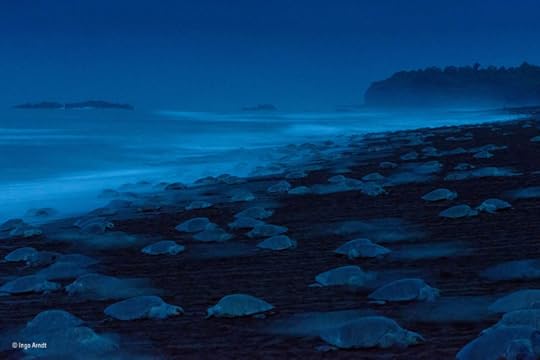
"Instead of standing still and waiting for instructions, what if he had laid his back in the midst of the mussels, laid there with barnacles poking his scalp, felt -- in the hollow echo chamber of his ribs -- the breakers pound against rock, listened to the shouts of faraway children and the pop of sand fleas next to his ear, as all the while tide crept in around him and surf exploded closer and closer to his brain?
"Then what would he have heard?
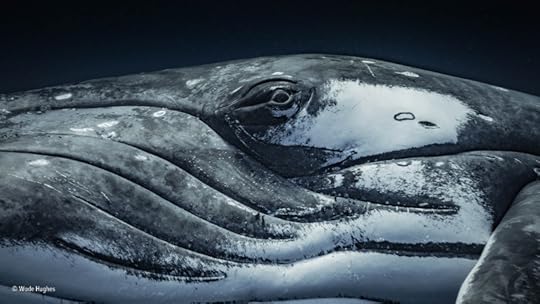
"I don't want to say he would have heard the voice of God.
"I want to say he would have heard -- really heard, maybe for the first time -- the squeak of mussels, the smash of surf, the peeping of sandpipers. Maybe a fish crow cawing or a chainsaw cutting cedar drifted in on storms.
"And I want to say this is enough. I want to say that this is astonishing enough -- the actual Earth, the extraordinary fact of the ticking, smashing, singing, whistling, peeping Earth -- to make me feel I live in a sacred place and time.
"I want to say there is a secular sacred, that this phrase, paradoxical as it seems, makes good and profound and important sense.
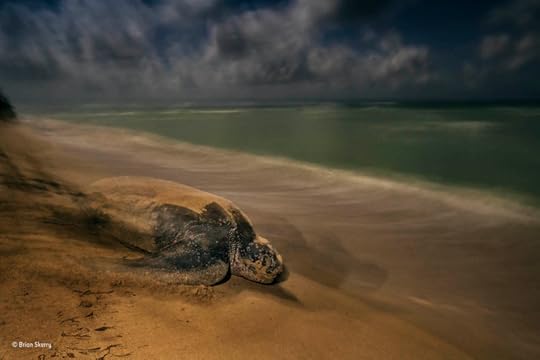
"Here is what I believe: that the natural world -- the stuff of our lives, the world we plod through, hardly hearing, the world we burn and poke and stuff and conquer and irradiate -- that THIS WORLD (not another world on another plane) is irreplaceable, astonshing, contingent, eternal and changing, beautiful and fearsome, beyond human understanding, worthy of reverence and awe, worthy of celebration and attention.
"If the good English word for this combination of qualities is 'sacred,' then so be it. Even if we don't believe in God, we walk out the door on a sacred morning and lift our eyes to the sacred rain and are called to remember our sacred obligations of care and celebration.
"And what's more, the natural world is sacred and 'sacred' describes the natural world; there are not too worlds but one, and it is magnificent and mysterious enough to shake us to the core; if this is so, then we -- you and I and the man on the beach -- are called to live our lives gladly. We are called to live lives of gratitude, joy, and caring, profoundly moved by the bare fact that we live in the time of the singing of birds."
If we allow for the concept of the "secular sacred," then I suppose that Wild Comfort is one of my sacred texts -- along with books by Barry Lopez, Terry Tempest Williams, Ursula Le Guin, Alan Garner, Patricia McKillip, John Crowley, Jane Yolen, Lloyd Alexander, David Abram, Lewis Hyde, Kathleen Jamie, Martin Shaw and so many others. They honor the mystery. Restore my sense of wonder. Remind me to be astonished by the world, and call me to gratitude and joy.

Pictures: The glorious photographs above were exhibited at The Museum of Natural History in London in the spring of 2016. They are identified & credited in the picture captions. (Run your cursor over the images to see them.) All rights reserved by the MNH and the photographers.
Words: The passage above is from "The Time of the Singing of the Birds," published in Wild Comfort: The Solace of Nature by Kathleen Dean Moore (Trumpeter Books, 2010); all rights reserved by the author.
Starting tonight...
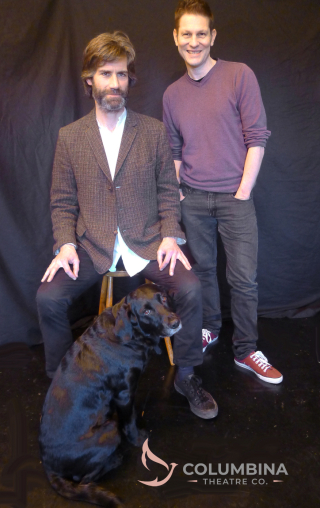 ...and then running every Thursday and Friday night through June.
...and then running every Thursday and Friday night through June.
Please come see what my husband Howard Gayton and his theatre partner Peter Oswald have been up to during the pandemic lockdown: creating onlive theatre for the age of Zoom, brought to you live from sheds in Chagford and Bristol. The tickets are free, just book one here. (Press the red "Select a date" button to pick the performance you want to attend.)
I've seen this bonkers, surreal, hilarious and poignant play during various parts of its development, but I'm going to watch it again on Friday, June 19th. Do any of you want to join me at that particular performance for a Myth & Moor watching party...?
And just so you know: Columbina Theatre has the Tilly Seal of Approval.
Starting tonight!
...And then running every Thursday and Friday night through June.
Please come see what my husband Howard Gayton and his theatre partner Peter Oswald have been up to during the pandemic lockdown: creating onlive theatre for the age of Zoom, brought to you live from sheds in Chagford and Bristol. The tickets are free, just book one here. (Press the red "Select a date" button to pick the performance you want to attend.)
I've seen this bonkers, surreal, hilarious and poignant play during various parts of its development, but I'm going to watch it again on Friday, June 19th. Do any of you want to join me at that particular performance for a Myth & Moor watching party...?
And just so you know: Columbina Theatre has the Tilly Seal of Approval.
June 10, 2020
On the shores of mystery
From Wild Comfort by Kathleen Dean Moore:
"Some people suggest that science is the enemy of the sacred. This puzzles me. I suppose the argument is that the more we understand or think we understand, the smaller the realm of mystery becomes; under the hot light of scientific knowledge, the sacred warps and shrinks, like Styrofoam in flames. But this argument won't work because mystery is infinite, the only natural resource that humans can't exhaust in this giant fire sale we call an economy.
"The physicist Chet Raymo thinks of scientific understanding as an island in a sea of mystery. The larger the island, the longer its coastline -- that area where the deep sea of what we don't understand slaps and smacks at the edge of what we think we know, a rich place of bright water and dark, fecund smell.
"If so, then this is our work in the world: to pull on rubber boots and stand in this lively, dangerous water, bracing against the slapping waves, one foot on stone, another on sand. When one foot slips and the other sinks, to hop awkwardly to keep from filling our boots. To laugh, to point, and sometimes to let this surging, light-flecked mystery wash into us and knock us to our knees, while we sing songs of celebration through our own three short nights, our voices thin in the darkness."
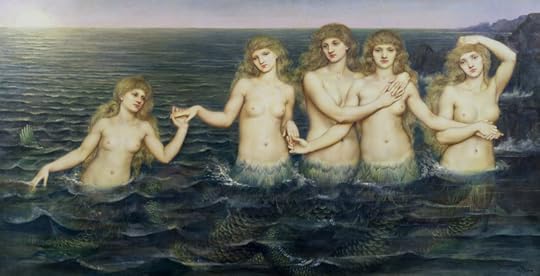
Words: The passage above is from Wild Comfort: The Solace of Nature by Kathleen Dean Moore (Trumpeter Books, 2010). The poem in the picture captions is from Red Bird by Mary Oliver (Beacon Press, 2009). All rights reserved by the authors.
Pictures: Two paintings for Hans Christian Andersen's "The Little Mermaid" by Edmund Dulac (1882-1953); a drawing for "The Little Mermaid" by Helen Stratton (1867-1961); Tilly & me on the Devon coast, pre-pandemic; and "Sea Maidens" by Evelyn de Morgan (1855-1919).
The magic of the world made visible
From "Learning to See" by Robin Wall Kimmerer (author of Braiding Sweetgrass):
"I remember my first encounter with the North Pacific, at Rialto Beach on the Olympic Peninsula. As a landlocked botanist, I was anticipating my first glimpse of the ocean, craning my neck around every bend in the winding dirt road. We arrived in a dense gray fog that clung to the trees and beaded my hair with moisture. Had the skies been clear we would have seen only what we expected: rocky coast, lush forest, and the broad expanse of the sea. That day, the air was opaque and the backdrop of the coastal hills was visible only when the spires of Sitka Spruce briefly emerged from the clouds. We knew the ocean's presence only by the deep roar of the surf, out beyond the tidepools. Strange, that at the edge of this immensity, the world had become very small, the fog obscuring all but the middle distance. All my pent-up desire to see the panorama of the coast became focussed on the only things that I could see, the beach and the surrounding tidepools.
"Wandering in the grayness, we quickly lost sight of each other, my friends disappearing like ghosts in just a few steps. Our muffled voices knit us together, calling out the discovery of a perfect pebble, or the intact shell of a razor clam. I knew from pouring over field guides in anticipation of the trip that we 'should' see starfish in the tidepools, and this would be my first. The only starfish I'd ever seen was a dried one in a zoology class and I was eager to see them at home where they belonged. As I looked among the mussels and limpets, I saw none. The tidepools were encrusted with barnacles and exotic-looking algae, anemones, and chitons enough to satisfy the curiosity of a novince tidepooler. But no starfish.
"Disappointed, I straightened up from the pools to relieve the growing stiffness in my back, and suddenly -- I saw one. Bright orange and clinging to a rock right before my eyes. And then it was as if a curtain had been pulled away and I saw them everywhere. Like stars revealing themselves one by one in a darkening summer night. Orange stars in the crevices of a black rock, speckled burgandy stars with outstretched arms, purple stars nestled together like a family huddled against the cold. In a cascade of discovery, the invisible was suddenly made visible.
"A Cheyenne elder of my acquaintance once told me that the best way to find something is not to go looking for it. This is a hard concept for a scientist. But he said to watch out of the corner of your eye, open to possibility, and what you seek will be revealed. The revelation of suddenly seeing what I was blind to only moments before is a sublime experience for me. I can revisit those moments and still feel the surge of expansion. The boundaries between my world and the world of another being get pushed back with sudden clarity, an experience both humbling and joyful."
You can read the full essay in Kimmerer's Gathering Moss, a lovely collection of linked essays on the natural and cultural history of mosses.
The magical ocean imagery today is from two Chagford artists who are also mother and daughter: Marja and Virginia Lee. (Each picture is identified in the hidden captions. Run your cursor over the images to see them.)
Marja Lee is a painter and harpist inspired by Celtic art, music, myth and mysticism. Born in the Netherlands, she studied art in Amsterdam, worked as a fashion illustrator in London, and then settled and raised her family here in Devon. Her delicate watercolor paintings and drawings are rich in esoteric symbolism, and fall into the Visionary tradition of such arists as Odilon Redon, Jessie M. King, and Sulamith Wulfing. The drawing just above and the painting below are by Marja. To learn more about her work, go here.
Virginia Lee is a painter and sculptor inspired by folklore, Surrealism, and the mythic landscape of Dartmoor. She has illustrated several fine books for children and adults, including The Frog Bride, Persephone, and The Secret History of Mermaids. She was also a sculptor on the set of the Lord of the Rings films, and has published exquisite decks of "oracle" and "story world" cards. To learn more about her work, go here.
Words: The passage above is from Gathering Moss by Native American author & plant biologist Robin Wall Kimmerer (Oregon State University, 2003). Pictures: The art above is by Marja and Virginia Lee; all rights reserved by the artists. The photographs of me and Tilly were taken by Howard.
June 9, 2020
Myth & Moor update
I'm out of the office due to health issues, but hope to be back tomorrow with more book recommendations for you.
"She���d opened the book she bought today. She���d started to read, from the beginning, quite quietly, out loud. It was the best of times, it was the worst of times, it was the age of wisdom, it was the age of foolishness, it was the epoch of belief, it was the epoch of incredulity, it was the season of Light, it was the season of Darkness, it was the spring of hope, it was the winter of despair, we had everything before us, we had nothing before us. The words had acted like a charm. They���d released it all, in seconds. They���d made everything happening stand just far enough away. It was nothing less than magic. Who needs a passport? Who am I? Where am I? What am I? I���m reading."
- Ali Smith (from the Autumn volume of her "Seasonal Quartet")
Tomorrow, back to the sea....
Words: The quote above is from Autumn by Ali Smith (Penguin 2017). The quotes in the picture captions are from a variety of sources. All rights reserved by the authora.
Pictures: "Reading by the Marsh" by Dennis Perrin, "Girl in a Hammock" by Winslow Homer (1836-1910), "Girl Reading" by Berthe Morisot (1841-1895), "Grace Reading at Howth Bay" bu William Orpen (1978-1931), and "The Little Mermaid" by Helen Stratton (1867-1961).
June 7, 2020
Tunes for a Monday Morning
Here in Devon, we're on a peninsula with two beautiful coastlines, north and south. Neither coast is particularly far from Dartmoor, but due to pandemic travel restrictions we haven't seen the ocean for months -- and as much as I love the moorland hills, I miss the sound and the scent of the sea. Today, let's listen to songs of the waves from across the British Isles.
Above: A short introductory film about Sea Songs -- an 18th-month project undertaken by Belfast musician M. Cambridge (Mark McCambridge), exploring traditional sea chanties, Ulster weaver-poetry, and sea-faring ballads old and new. The resulting album, Sea Songs: Anatomy of a Drowning Man (2019) is an unusual blend of music and spoken word, and well worth a listen. The film is by Sam O'Mahony.
Below: "My Sailor Boy," from Sea Songs: Anatomy of a Drowing Man.
Above: "Port na bP��cai" by Irish folksinger Muireann Nic Amhlaoibh, with Billy Mag Fhloinn. This traditional song from the Blasket Islands of Co. Kerry tells the story of a woman "from across the waves" who has been stolen away by the fairies, never to return.
Below: "Thaney" by the Scottish folk band Malinky, from their early album Three Ravens (2002). The ballad (written by Karine Polwart) recounts the medieval legend of Saint Thaney, the daughter of the King of Lothian, who was raped by a callous prince of Wales and conceived a child by him. Her father, infuriated by the pregnancy, commands his daughter be hurled from the cliffs to the sea. Miraculously surviving the fall, Thaney is put on a tiny coracle and set adrift on the Firth of Forth. She survives this ordeal too, and gives birth to a son, Saint Kentigern, the founder of the city of Glasgow.
"But wonders on the bonnie lady / Wonders on the silver spray / Cradled by five thousand fishes / It's she has reached the Isle o' May / Through the turning tide they tumbled / Through the rattlin', rollin' storm . Safe at Culross Kirk she has landed / There she has her baby born."
Above: "Dh�����irich mi moch, b' fhe��rr nach do dh�����irich" by Scottish singer/songwriter Julie Fowlis, from the island of North Uist in the Outer Hebrides. The song appeared on her most recent album, Alterum (2017). "My work is steeped in tradition and historical reference specific to the Highlands," she says. This song evokes the contrasting elements of land and sea, with owl feathers symbolic of journeys, transitions, and ancient rites of women's mysticism and intrigue.
Below: "��ran an R��in," another song from Alterum, with a new video that was released last month. This one, says Fowlis, "is a traditional Gaelic song from the voice of the seal people or selkies: creatures who were said to shed their seal skin and take on the human form at certain times of the year, moving between the parallel worlds of sea and land, but never truly belonging to either."
Above: "The Selchie Song," written and sung by Scottish singer/songwriter Jenny Sturgeon, accompanied by Jonny Hardie, on the Isle of May in 2014. Sturgeon has a new album coming out this autumn inspired by Nan Shepherd's classic book The Living Mountain; and her two albums with Salt House, Undersong and Huam, are just stunning.
Below: "The Grey Selkie of Sule Skerry" (Child Ballad 113), a traditional song of the Orkney and Shetland islands, performed by English singer/songwriter Maz O'Conner. The video of seals is not from O'Connor but underscores the song beautifully, filmed by divers off the coast of Coll in the Inner Hebrides, and the Farne Islands of Northumberland. The song itself can be found on O'Conner's second album, This Willowed Light (2014).
And one more song to end with, below:
"The Sailor's Farewell" by English singer/songwriter Ange Hardy, based in Somerset. The song appeared on her third album, The Lament of the Black Sheep (2014).
Photographs: Howard and Tilly on the south Devon coast, near Burgh Island, pre-pandemic.
Terri Windling's Blog
- Terri Windling's profile
- 710 followers


